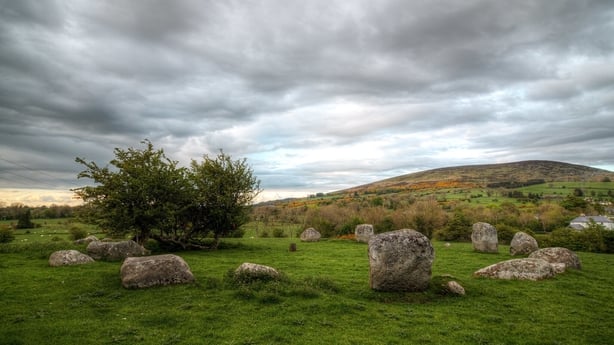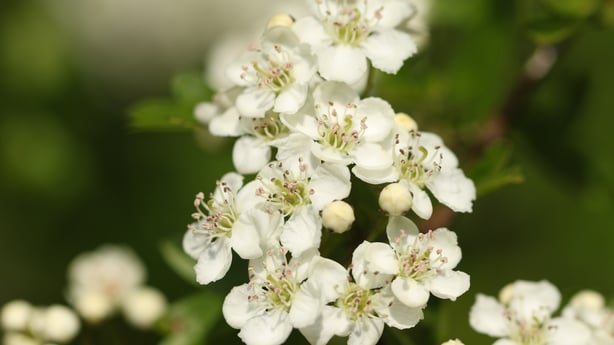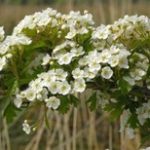Death, sex, superstition and fear: the hawthorn tree in Ireland
Updated / Thursday, 7 May 2020 07:18

Opinion: why was the hawthorn tree regarded in Irish folklore and tradition as one to be avoided?
By Marion McGarry, Galway Mayo Institute of Technology
People enjoying the outdoors in many parts of Ireland at this time of the year will start to notice white flowers appearing in hedgerows, field boundaries and along roadsides. So begins the annual appearance of hawthorn flowers which light up the Irish countryside throughout the months of May and June, sometimes blushed with pink. Also known as whitethorn, it is a common small deciduous tree, traditionally used by farmers who found its prickly thorns useful in hedging to contain livestock.
At this time of the year, a tradition was to bring a branch of the hawthorn into the garden and decorate this “May bush” with eggshells and flowers. Right into living memory, Irish children on hungry long walks home from school would snack on the new leaves appearing in spring (before the flowers appeared) that were known colloquially as “bread and cheese”. We often also see it sanctified at Christian holy wells, sometimes with offerings tied to it. These rag trees offer the hope that as the tied offering disintegrates, so too will the ailment or worry it was placed there to represent.
Yet there is a reticence associated that the late poet Eavan Boland called the “superstitious aura of hawthorn”. This may be a remnant of the ancient Irish regard for sacred trees that was part of the prehistoric pagan worship of nature. Later, trees in Ireland were associated with the development of the Ogham alphabet, and tellingly, the letter associated with hawthorn within that ishUath, thought to mean “fear”.

Often, we see single hawthorn trees standing alone in fields, or on old ring forts, untouched by farmers. Variously known as gentry thorn, lone bushes or skeaghs, there are tens of thousands of them across Ireland. They look gnarled, weathered and otherly throughout the winter months without the green clothing of their leaves.
These trees that grew of their own accord, unplanted by human hands, are those most regarded with fear and superstition. These are thought of as faery trees, associated with those unseen beings from the other world. They are believed to mark the places where the faeries, after dark, would assemble and play sweet ethereal music, ready to abduct any beautiful human who took their fancy. Faeries could potentially destroy the crops, livestock, health, fortune or luck of anyone they took a dislike to, or anyone who had somehow wronged them. Thus, anything associated with faery activity in Ireland was traditionally avoided by the people who used many rituals to appease them.
Hawthorns are often called May trees due to their flowering coinciding with that month, and May 1st marks the Irish festival of Bealtaine, an important one in the traditional Irish calendar year that marks the beginning of summer. Before the change in the calendar in 1752, Hawthorn would have been in full flower in most parts of the country in time for Bealtaine Eve, a night most associated with malevolent faery activity and one where the house and its luck was to be especially protected.

The next major Irish festival associated with heightened faery and supernatural activity is Oíche Shamhna, or Hallowe’en, marking the beginning of winter. Then, hawthorn is in full berry, as decorated with vibrant red haw berries as they are with flowers in May. To be in flower and full of berries alternately at these times of the year must have lent hawthorn a special air to people who held such festivals in great importance in ancient times.
The Schools’ Collection of Irish folklore abounds with stories of lone Hawthorn growing over buried pots of buried gold, concurrently with tales of people coming to a bad end if they interfere with or cause damage to these trees or utilise their fallen timber. Avoidance of these trees was the central message imparted to the child collectors of folklore, and above all bringing the flowers into the home was forbidden, as they would cause very bad luck.
Why was this tree singled out in Irish tradition as the one to be avoided, with its associations with faery merriment, retribution and bad luck? If we look at its oft neighbour, the blackthorn, we see many physical similarities, but it does not get such a bad press as the hawthorn. Blackthorn too, is a prickly tree used for hedge boundaries and has white flowering in April, but is beloved in Ireland for its useful hard timber (used for handles, sticks and shillelaghs).
These trees that grew of their own accord, unplanted by human hands, are those most regarded with fear and superstition
Some suspect that the answer to this lies in the unexpectedly unflowery smell of hawthorn flowers, and this brings us to aspects never discussed with those innocent collectors of schools’ folklore. Hawthorn flowers omit a particular smell to attract mainly carrion insects (such as flies) to pollenate them. This is due to a chemical contained in the flowers called triethylamine that has a stale element reminiscent of gangrene or decomposing dead bodies.
This smell was more familiar to people long ago. In the days before modern embalming techniques, people often laid out their own dead relatives or neighbours, and sat with them during wakes, which were attended by great numbers of the local community. The decomposing smell would have been recognised as being closely associated with death. Paradoxically, triethylamine also gives the flowers a musky fragrance that some associate with the smell of sexual bodily fluids. These connotations of death and sex, largely missing from Irish folklore, perhaps sealed the fate of hawthorn as being regarded as strange, inappropriate and unwelcome inside the home and outside, something to be avoided.
Dr Marion McGarry is an art historian, author, independent researcher and lecturer at Galway Mayo Institute of Technology


